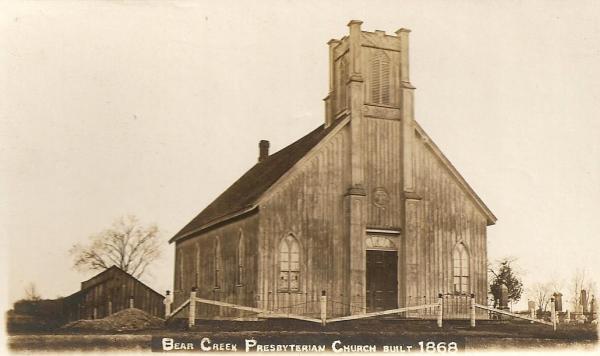
At a time when most of Upper Canada was still a vast forest, and roads, where they existed, were muddy trails for much of the year, waterways were the easiest means of transportation. Accordingly, the earliest settlement of the western side of what would become Lambton County occurred along the St. Clair River. Very early settlement also took place inland where Bear Creek provided the water for transportation. Bear Creek settlement began in the early 1830’s in the former Moore Township.
The first arrivals were from Ireland in 1832, the William Tremells Family, who settled on Lot 17 of the sixth concession. They were followed in 1833 by Charles Duncan who chose lot 6 of the fifth concession. In spite of the first settler being Irish, Bear Creek was almost exclusively a Scottish settlement. The year 1834 saw the arrival of Peter Duncan, John Grant, John Galloway, John McKenzie, Samuel Harkness and George Gray. Later in the 1830’s, Finlay Farquharson, John Coutts, Robert Faithorne, Robert Brown, James King, James Butler, James Lang, and William, James, Alex and David Nisbet arrived.
Many difficulties faced these early settlers. Shortly after their settlement in the area, the men were called away from their new homes for a year, to serve for military duty on the St. Clair River during the rebellion of 1837-38. Supplies had to be obtained from great distance and transportation remained a hardship. The Bear Creek settlers reportedly obtained seed for planting grain between the stumps of their freshly cleared fields from the area of the former Baldoon settlement, near Wallaceburg (also of Scottish origin). Due to the meandering course of Bear Creek and the Sydenham River, such a trip by canoe would be about 80 miles, compared to an easy round trip of an hour by car today.
Immigration from Scotland continued throughout the 1840’s and 1850’s, with the following families joining the Bear Creek settlement: William Whittet, Finlay McKenzie, John McDonald, Adam McDonald, Alexander, William and John Watson, Duncan Warren, Alexanders, John Shaw, Andersons, Lincolns, Barnes, Boothes, Gaulds, John, Lewis, Angus and Peter McBean, McKellars, McLeans, McLarens, Ewen McAuley, Morrison, Miller, Lewis Cummings, Carter, Croswell, Courtney, Welsh, McHenry, James Watson, John, Donald and Alexander Taylor, South, Thompson, Young, John Murdock, Dalton, Fisher, Fiddes, White, Burns, Beaton and Rattray.
Positive reports must have been sent back to Scotland by the first arrivals, for the parish of Rothiemurchus, Invernesshire, had more than 20 people become residents of Bear Creek. The Bear Creek settlers were almost exclusively Scottish, and the history of Bear Creek is closely tied to the history of Bear Creek Presbyterian Church.
As early as 1834, Rev. George Cheyne, a Presbyterian minister from Amherstburg, was conducting worship services along the St. Clair River. In 1838 or 1839, he made a difficult trip, on foot, inland to Bear Creek, where he conducted a service at the home of Finlay Farquharson. Beginning in 1843, Rev. William McAllister of St. Andrew’s Presbyterian Church, Sarnia, provided for the pastoral needs of the people of Bear Creek, and conducted worship services on a weekday. It was not until 1849 that the settlers in this area were able to have worship services on Sunday, and then only twice per year.
By 1855, Bear Creek had enough settlers to make the congregation a mission station, independent of St. Andrew’s church. In that year, the first Bear Creek Presbyterian Church building was constructed, on lot 10, concession 6, Moore Township. Lack of a local sawmill meant that lumber had to be obtained in St. Clair, Michigan in the winter and brought back over the frozen river and creek.
The cemetery actually predates the church building, as land was acquired in 1845 for a cemetery and future church site. The first burial in this cemetery was the infant son of John Coutts, in 1850. The first adult burial was John McDonald in 1851.
The first minister inducted in the new church was Rev. John Gauld, in 1855. Throughout the early years of the church, for communion services a Gaelic service would also be conducted, as many of the older members did not speak English. These Gaelic services were held in the churchyard at first and later in Louis McBean’s home.
This first building burned in 1867, the Bible being the only item saved. Adam McDonald went in through a window to salvage it. The fire was felt to be suspicious enough that a $100 reward was offered for information, but none was forthcoming.
The new building was erected the following year and was used until 1909 when a more modern building was desired by the congregation. This building was opened in 1910 and served the congregation until 1987, when a declining number of members led to the closing of the church. Most of the remaining members moved to Brigden Presbyterian Church.
Today, all that remains of Bear Creek settlement is the cemetery and a cairn marking the location of the church – and the wealth of Scottish names on mailboxes in this area of Lambton.
Sources:
History of Bear Creek Presbyterian Church, 1843 – 1933, by Isabella C. Finlayson
History of Bear Creek Presbyterian Church, 1843 – 1955
History of Bear Creek Presbyterian Church, 1843 – 1987, by Queenie McBean
Lambton Centennial Series, No. 5 – The First Scots at Bear Creek, by Beatrice Long Carter

